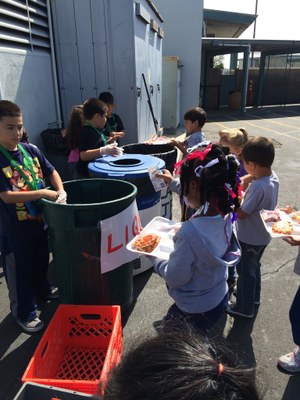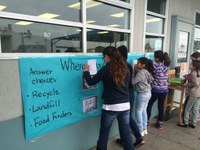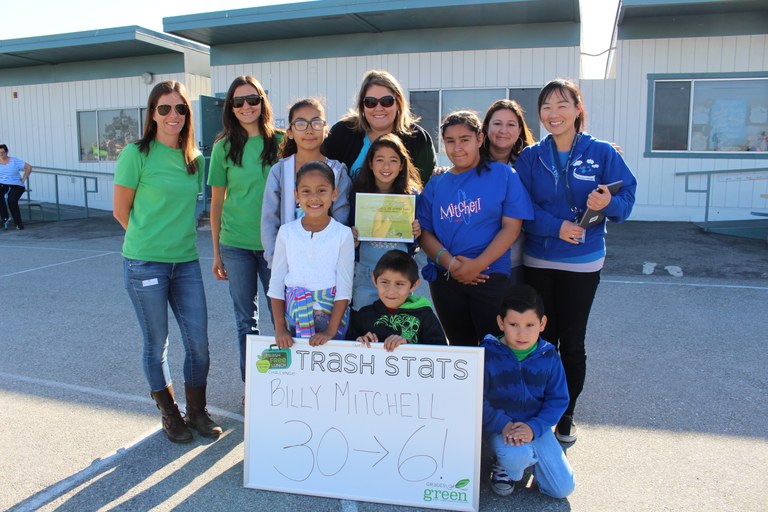Grades of Green: Team Lead
Project Rationale
 Practicing environmental responsibility is not an option in today’s global world. The effects of our environmental choices affect the lives and well-being of not only my students, but the world. Grades of Green is a non-profit organization that work with schools in reducing lunch time waste and promotes earth-friendly thinking. Through partnership with the Grades of Green program, my hope was to raise environmental awareness of my school community. By increasing awareness through a kick-off assembly and daily lunch recycling activities, my hope was to empower students as citizens and build self agency in taking care of our environment. Through the implementation of the program and entering into the Grade of Green “Trash Free Challenge” competition, our daily trash waste went from 50 bags a day to an amazing 12 bags a day. Specifically, the lunch time trash was decreased from 30 bags to 6 bags. However, the most important change was what I noticed in the students’ conversations and practices. Even very young first grade students were enthusiastic about recycling waste and recognizing that many of our recyclables end up in landfills which is harmful for our environment and future.
Practicing environmental responsibility is not an option in today’s global world. The effects of our environmental choices affect the lives and well-being of not only my students, but the world. Grades of Green is a non-profit organization that work with schools in reducing lunch time waste and promotes earth-friendly thinking. Through partnership with the Grades of Green program, my hope was to raise environmental awareness of my school community. By increasing awareness through a kick-off assembly and daily lunch recycling activities, my hope was to empower students as citizens and build self agency in taking care of our environment. Through the implementation of the program and entering into the Grade of Green “Trash Free Challenge” competition, our daily trash waste went from 50 bags a day to an amazing 12 bags a day. Specifically, the lunch time trash was decreased from 30 bags to 6 bags. However, the most important change was what I noticed in the students’ conversations and practices. Even very young first grade students were enthusiastic about recycling waste and recognizing that many of our recyclables end up in landfills which is harmful for our environment and future.

Leadership Activities
In October the Grades of Green Team came to our school site and performed a preliminary review regarding the status of the school’s trash/recycling program. With advice from the Grade of Green Team and with our school’s own Mitchell Green Team, we set up a kick off assembly in early December. Before the kick-off assembly, I communicated with the district office, specifically the maintenance department, regarding our recycling bins, recycling pick-ups, and other information necessary for the implementation of the lunch time trash sorting process. In addition, during the implementation, I also communicated with the food services department and the master gardener at our school site to expand the recycling program on site for the future. After the kick-off in December, in collaboration with the Mitchell Green Team members, students were trained and educated during lunch time on the practice of trash sorting. The program has been in full implementation since then. In February, a quiz was created and raffle prizes were given out to encourage trash sorting during lunch time. In March, I turned in the final application for the “Trash Free Challenge” competition. By mid-April, our school was awarded the Best Super Sorter Award and the Grade of Green Team visited our campus to present our students with the Recognition Award.
One of the unexpected aspects of the program that I had to revisit and think about was the difficulty of donating uneaten school food to neighborhood food banks and other food organizations. First, I contacted foodfinders.org and then, our master gardener contacted the Lawndale Commodities program. However, after consultation with our district’s Food Services department, we were not able to donate food due health safety concern.
CAPEs Connection
My activities in implementing the Grade of Green recycling program connects to the following CAPEs:
CAPE 2 (Developing Shared Commitment to Vision: I had to develop a vision for the Mitchell Green Team and then share our vision with the entire school community.
CAPE 4 (Sharing Leadership with Others): I had to work collaboratively with the head custodian, fellow teachers, students and parent member to put the Green Team vision into practice. In addition, I worked with our district office personnel to include the district in our process.
CAPE 11 (Identifying and Using Resources): I used my knowledge regarding district logistics and also researched possible resources (master gardener and food bank) that could help implement the Trash Free Challenge program. If I did not have information, I sought out the proper personnel or resources that might help facilitate our process.
CAPE 16 (Understanding and Managing the Complex Interaction): In the process, I used technology to facilitate communication and to manage information as well as used spaced to meet the needs of the Green Team.
CAPE 18 (Implementing California School Requirements and Regulations): In respect to donation of uneaten school food, I had to ensure that the issue was according to the school practices that met legal health and safely measures.
CAPE 19 (Representing School’s Accomplishments and Needs to LEA and Community): To make sure that the Grades of Green Trash Free Challenge went off without a hitch, I help coordinate and hold a kick off assembly, a Trash Free Challenge school-wide quiz and the culminating assembly with the entire school community, district staff, and families.
CAPE 20 (Involving the Community in Helping Achieve Vision and Goals): To help realize the environment awareness at our school, my team was composed of staff, students, master gardener and a parent representative. As a team, we involved the entire school community in sharing information regarding the Trash Free Challenge as well as environmental awareness. Organizations, such as the food bank and foodfinders.org were contacted to involve the community in achieving the Green Team goals.
Reflection
My role was the lead teacher for the Grades of Green Trash Free Challenge at my school site. It involved a lot more coordinating with the district and student population than I had first imagined. Before the program even got started, I had to coordinate with the district’s Maintenance department as well as the Food Services department. In addition, there were more conversations with support staff that had to take place in order for the lunch sorting to occur without a hitch. The program ended successfully. Our lunch time trash bag count went from 30 bags to 6 bags a day, a significant decrease. Furthermore, the conversations that were heard on school site demonstrated the students’ increase in environmental awareness as well as their commitment to recycling. Entire school is still recycling even after the competition portion ended. It was encouraging to build a vision with the team, work collaboratively with them and roll out a program together. The only difficulty was with the food donation issue and I am still thinking about ways in which school can donate uneaten food instead of wasting them. Next time, I would start the research on implementing this program earlier in the year and hold a few family nights throughout the process to provide additional information sessions for families.



